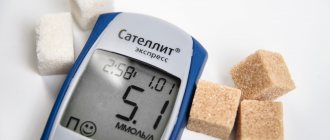Diabetes mellitus is common in patients with hypertension and significantly increases the risk of cardiovascular disease, including myocardial infarction, stroke, and peripheral vascular disease. Pharmacological therapy in patients with hypertension and diabetes is controversial due to concerns about the metabolic effects of some antihypertensive agents, as well as concerns about the safety of calcium antagonists. Therefore, diet, lifestyle changes and knowledge about proper prevention of disease progression are the key to maintaining health and reducing the risk of developing cardiovascular complications.
Factors affecting blood pressure
The cause is unknown in most cases. This is called essential hypertension. The pressure in the blood vessels depends on how hard the heart pumps blood and how much resistance the blood vessels (arteries) offer. The slight narrowing of the arteries is thought to increase resistance to blood flow, which increases blood pressure.
What Causes High Blood Pressure?
Most people don't have a single reason. However, there are a number of things that increase the likelihood of its occurrence. These are the so-called risk factors:
- The influence of nicotine.
- Excessive consumption of salt or processed foods (convenience foods, canned foods, smoked foods).
- Alcohol abuse.
- Having excess weight.
- Insufficient physical activity.
- Private stress, which provokes the release of adrenaline and cortisol.
In addition, diabetic nephropathy, a complication that develops in some people with diabetes, can cause hypertension in patients with diabetes. In this condition, the kidneys are damaged, which can cause high blood pressure due to damage to the arteries, arterioles, tubules and glomeruli of the kidney tissue. It is more common in people with type 1 diabetes. In rare cases, high blood pressure is caused by other medical conditions. This is then called secondary hypertension. For example, kidney problems or hormonal imbalances can cause high blood pressure.
What is characteristic of this type?
The first stages of the disease are characterized by an excessive amount of insulin produced, which subsequently leads to disturbances in the functioning of the pancreas. The result is abnormal metabolism, the manifestation of glucose toxicity and lipid toxicity.
As a result, tissue resistance to insulin develops. The pancreas, in order to balance carbohydrate and lipid metabolism, begins to secrete even more insulin. As a result, a vicious circle is formed.
How is blood pressure measured?
Blood pressure is measured using a device called a tonometer. A cuff (thick tape) is placed on the arm.
As air is inflated, the cuff tightens and then slowly relaxes again. During this relaxation, you can listen to the pulsation of the arteries and record the first and last tone to record blood pressure readings. Blood pressure is measured in millimeters of mercury. After the study, the result will be recorded in two numbers: the first is systolic pressure (during ventricular contraction), the second is diastolic pressure when the heart muscle is at rest. According to the principle of operation, tonometers are automatic and manual. When using a manual tonometer, air is pumped using a special bulb, and the first and last tone is heard using a stethoscope.
The automatic blood pressure monitor inflates the cuff and catches the pulse itself. Also, such devices measure heart rate and have a built-in memory for recording readings. It is much more convenient than manual ones, especially for older people.
Drugs
Modern pharmacology offers doctors and patients a fairly wide selection of drugs with antihypertensive effects. However, the presence of diabetes mellitus implies a large number of restrictions on their use. When choosing the right drug, the following factors should be taken into account:
- The nature of the effect on carbohydrate and lipid metabolism. You should choose a drug that will improve this metabolism, or, in extreme cases, will not have any effect at all.
- The drug should not have contraindications for use due to liver and kidney diseases.
- The medication must have organoprotective properties. It is worth giving your preference to the drug that can improve the functioning of organs that are already damaged.
So choosing pills for high blood pressure for diabetes can be difficult.
Treatment and prevention of high blood pressure
To avoid a diagnosis of hypertension, patients with diabetes need to adjust their lifestyle in the following ways:
- Maintain a healthy weight. Overweight people should try to lose weight, while people of normal weight should avoid gaining weight. If you are overweight, losing just 5 kg can help prevent hypertension. Talk to your doctor about the most appropriate weight for you.
- Eat a balanced diet. Eat plenty of fruits and vegetables, especially those rich in potassium, and limit your intake of excess calories, fat and sugar. Consider following the Dietary Approaches to Control Hypertension, or DASH diet, which has been shown to help control blood pressure in patients with diabetes.
- Reduce the amount of salt. A low-sodium diet can help maintain normal blood pressure. The higher your sodium intake, the higher your blood pressure. You can reduce your overall salt intake by avoiding packaged and processed foods that are high in sodium and not adding extra salt to your meals.
- Exercise regularly. Get moving to prevent hypertension. Physical activity is critical. The more you exercise, the better, but even light exercise can help control your blood pressure. Moderate exercise for 30 minutes three times a week is a good start.
- Limit your alcohol intake. Excessive alcohol consumption can lead to high blood pressure.
- Check your blood pressure regularly. If your doctor detects early signs of hypertension (prehypertension), additional precautions may be needed to correct the condition.
Take a look at your lifestyle and decide where you can make changes to prevent hypertension. Achieve small goals, like snacking on fruits and vegetables instead of junk food, and continue to practice these healthy habits until they become part of your daily life.
What does lipid toxicity lead to?
It is important that lipid toxicity stimulates the rapid development of diseases such as atherosclerosis, excess insulin, and, in turn, arterial hypertension, as a result of which even more severe complications develop. The risk of:
- strokes;
- neuropathies;
- gangrene;
- nephropathies;
- heart failure.
How to choose blood pressure pills for diabetes?
Treatment with medications
If you have diabetes, the use of antihypertensive therapy is recommended in cases where blood pressure remains at 140/80 mmHg. even when adjusting your lifestyle through diet, exercise, etc. Target blood pressure is below 130/80 mm Hg. Art. is mandatory if the patient has complications such as damage to the retina, kidney (nephropathy) or brain tissue (stroke).
There are several different medications that can lower blood pressure readings. The choice depends on things like:
- Do you have other health problems?
- Are you taking other medications?
- Possible side effects of the medicine.
- Patient's age and ethnicity.
The first group of drugs that is most often used is a drug called an angiotensin-converting enzyme (ACE) inhibitor. ACE inhibitors protect against kidney damage and also help control blood pressure.
One drug lowers blood pressure to target less than half the time. Therefore, this means that two or more different medications are usually required to achieve the target level (140/80 mmHg or below). In about a third of cases, three or more medications are needed to lower blood pressure to target levels. Therefore, patients with a combination of diabetes mellitus and arterial hypertension need regular consultations with doctors to monitor their health status and adjust treatment.
Diagnosis of diabetes mellitus
The following methods and tests have been established for diagnosing diabetes mellitus:
- measuring blood glucose levels (determination of glycemia);
- measurement of daily fluctuations in glycemic levels (glycemic profile);
- measuring insulin levels in the blood;
- glucose tolerance test;
- blood test for the concentration of glycosylated hemoglobin;
- blood chemistry;
- urine test to determine white blood cell, glucose and protein levels;
- Ultrasound of the abdominal organs;
- Rehberg's test.
In addition, if necessary, carry out:
- study of blood electrolyte composition;
- urine test to determine the presence of acetone;
- fundus examination;
- electrocardiography (ECG).
Reviews
Reviews about blood pressure medications for existing diabetes are different. There are many positive things about beta blockers, ACE inhibitors, and diuretics are also often used. But all means should be used with caution, because it is so easy to make a mistake in the choice and get a lot of adverse reactions. Taking medications to treat the disease is not enough. Even complex therapy will not bring the expected effect if you do not change your own lifestyle.
Only a doctor can select good blood pressure pills for diabetes. Self-medication is unacceptable.
Why is low blood pressure dangerous in diabetes?
Low blood pressure in diabetes is sometimes more dangerous than high blood pressure. Under normal conditions, a decrease in pressure causes a compensatory spasm, which helps maintain blood supply to the tissues. Due to microangiopathy caused by diabetes, the vessels of the kidneys and microvasculature cannot contract, so the blood supply to all tissues suffers.
Constant oxygen starvation leads to the development and worsening of diabetic encephalopathy, impairs vision and contributes to the formation of trophic ulcers on the extremities. The condition of the kidneys worsens and renal failure develops.
A sharp decrease in blood pressure in type 1 and type 2 diabetes can lead to cardiogenic shock - an urgent condition that requires emergency medical intervention. If signs of low blood pressure appear suddenly, you should call an ambulance to prevent acute renal failure and cardiogenic shock.
Low blood pressure in diabetes: causes and symptoms
Low blood pressure in diabetes is much less common than hypertension. This is due to the cascade of obligatory disorders that hyperglycemia leads to. Low blood pressure can occur either at the onset of diabetes mellitus, which has nothing to do with the disease and is a feature of this patient. Over time, such hypotension develops into normal pressure, and then into arterial hypertension due to impaired renal function.
It happens that arterial hypertension develops into hypotension. This condition is dangerous. For a diabetic patient, even a blood pressure of 110/60 can become very severe and lead to fainting. Therefore, patients should monitor their blood sugar and measure their blood pressure daily.
Causes of hypotension in diabetes:
- Disruption of the autonomic nervous system due to increased fatigue, stress and vitamin deficiency. Lifestyle correction in most cases allows you to correct this situation if it is not running.
- Heart failure due to damage to the heart and coronary arteries. This condition is very dangerous and develops in advanced cases. Patients with heart failure and diabetes require mandatory hospitalization and specific treatment.
- Overdose of medications that lower blood pressure. If hypertension in diabetes suddenly turns into hypotension, the patient did not follow the doctor’s recommendations correctly. This is not a reason to quit taking pills and wait for your blood pressure to rise, because sudden changes can lead to life-threatening conditions. You should consult a doctor so that he can review the prescribed treatment and normalize the blood pressure.
It is difficult to say what kind of blood pressure in diabetes will be considered low. Therefore, it is important to focus on the tonometer readings and your well-being. Low blood pressure manifests itself with the following symptoms:
- Dizziness;
- Pale skin;
- Cold sweat;
- Frequent but weak pulse;
- Flashing of flies before the eyes (may accompany hypertension and hypotension).
This is a manifestation of a sharp drop in pressure. When it is constantly reduced, symptoms will not be expressed. In hypotensive patients, a constant feeling of fatigue, drowsiness, and coldness in the fingers and toes comes to the fore.
Diabetic neuropathy leads to orthostatic collapse - a sharp drop in blood pressure when moving from a lying position to a standing position. This is manifested by darkening of the eyes, sometimes short-term fainting. To detect hypotension, blood pressure in diabetes should be measured in the supine and standing positions.
Alpha blockers
Alpha-blockers include Doxazosin, Terazosin, and Prazosin. Their main difference from most beta blockers is that they have a positive effect on carbohydrate and lipid metabolism and tissue resistance to insulin. However, there are some side effects. Alpha blockers can cause the following:
- Orthostatic hypotension.
- Edema.
- Persistent tachycardia.
Due to the fact that patients with diabetes often suffer from orthostatic hypotension, characterized by a sharp decrease in blood pressure when changing posture, these drugs should be taken with great caution.
It must be remembered that all drugs belonging to the group of alpha-blockers are strictly contraindicated in the presence of heart failure.
Beta blockers
These drugs are recommended for use in the treatment of hypertension associated with arrhythmic manifestations and coronary artery disease. When choosing a drug, you should pay special attention to such characteristics as:
- Hydrophilicity and lipophilicity.
- Selectivity.
- Vasodilating effect.
Non-selective drugs, which include Nadolol and Anaprilin, affect receptors located in the pancreas. Such drugs can inhibit insulin secretion. For diabetes mellitus, doctors recommend using selective beta blockers as an antihypertensive agent, which include Bisoprolol, Metoprolol, and Atenolol. Their indications are approximately the same. In addition to their main effect, they also have a positive effect on the functioning of the heart.
Drugs that are lipophilic are eliminated from the body by the liver. These drugs include Pindolol and Metoprolol. Taking them in the presence of diabetes mellitus is extremely undesirable due to the fact that diabetes is often accompanied by liver failure and impaired lipid metabolism. Another disadvantage is that they can cause depression in the patient.
Beta blockers, which are hydrophilic, have a more prolonged effect and do not depress the psycho-emotional state or interfere with the functioning of the liver and kidneys. This group of beta blockers includes Nadolol and Atenolol.
For example, for the drug "Nebivolol", the instructions for use indicate that beta blockers, which have a vasodilating effect, have a positive effect on lipid and carbohydrate metabolism, and can increase the sensitivity of tissues to the effects of insulin. However, these drugs have a wide range of side effects. These include Corvitol and Nebivolol. Instructions for use are included in each package.
Corvitol is a drug that has powerful antiarrhythmic, antianginal and hypotensive effects. Prescribed for hypertension, tachycardia, heart rhythm disturbances, and coronary artery disease. But in case of diabetes mellitus, it must be used with great caution. This is confirmed by the instructions and reviews for the drug “Corvitol”.
Taking into account all the factors described above, it is necessary to understand that the choice of an antihypertensive drug should only be made by a doctor.









